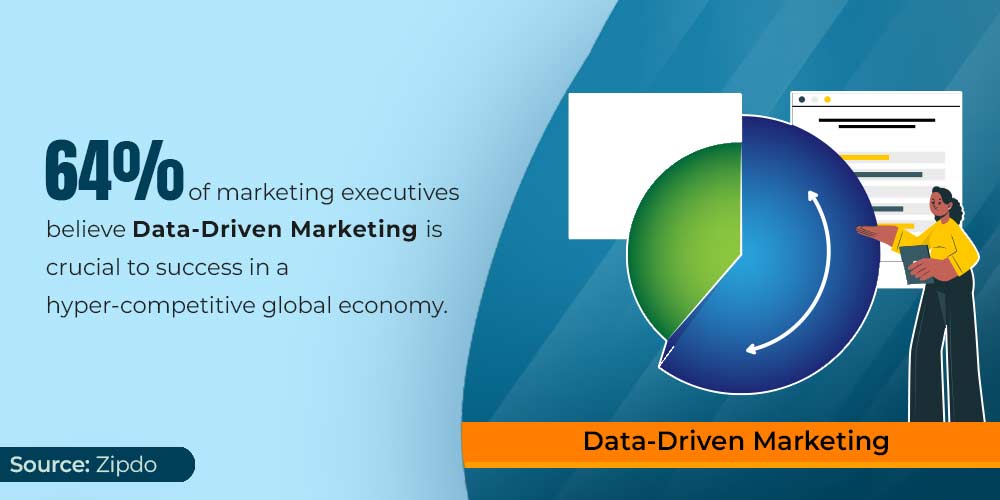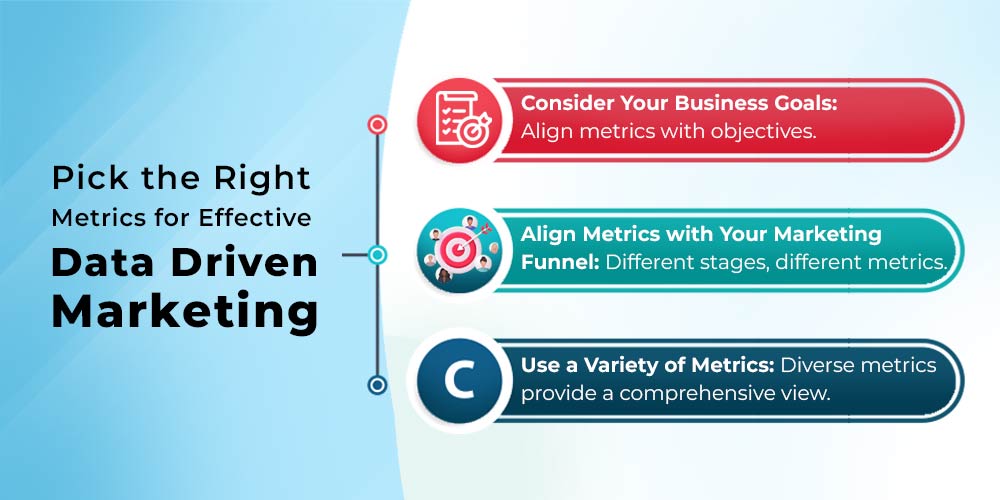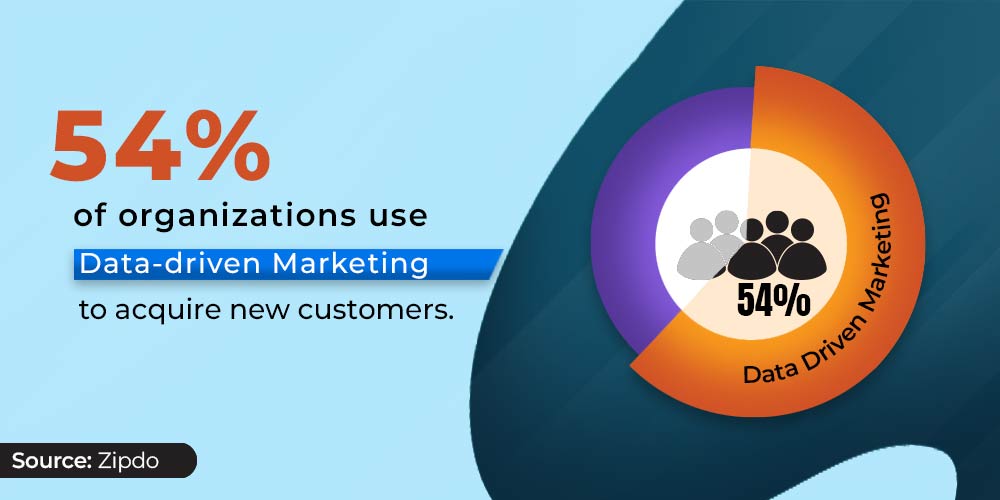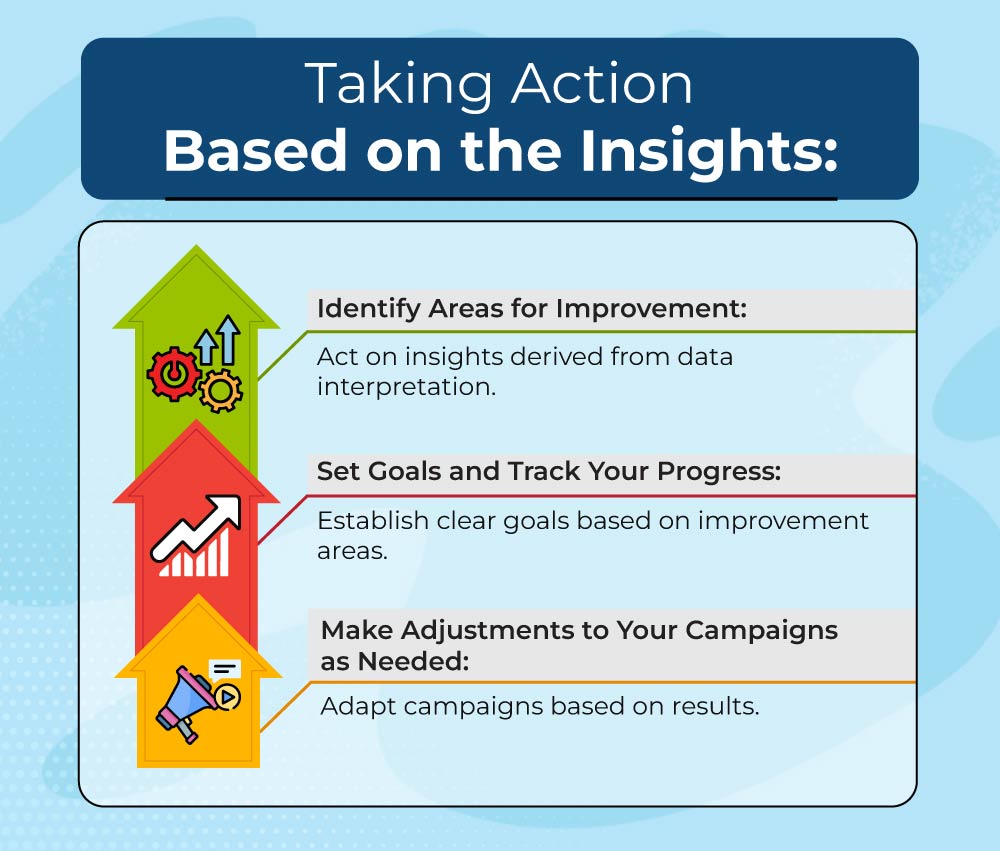Data-Driven Marketing: A Comprehensive Guide
Introduction
In today’s dynamic digital marketing landscape, Data-Driven Marketing reigns supreme. Every click, every like, and every scroll holds valuable insights that can make or break your marketing campaigns. To navigate this data-driven landscape effectively, you need to master the art of choosing the right metrics, setting up tracking tools, collecting and analyzing data, interpreting the results, and taking action based on the insights. Data-driven marketing is the linchpin of success in the digital age, where every click and interaction can be a valuable source of insight.


This comprehensive guide will equip you with the knowledge and tools to become a proficient data-driven marketer. Whether you’re looking to boost brand awareness, generate leads, or drive sales, the tips, tricks, and insights presented here will help you make informed decisions and achieve your marketing goals. 64% of marketing executives believe Data-Driven Marketing is crucial to success in a hyper-competitive global economy.
Choosing the Right Metrics to Track


Consider Your Business Goals
When determining which metrics to track, it’s essential to align them with your business objectives. For example, if your goal is to increase brand awareness, focus on metrics such as social media engagement and website traffic. If you aim to generate leads, you might want to track metrics like lead submissions and form completions. In the realm of Data-Driven Marketing, choosing the right metrics to track is a fundamental step.
Example: Suppose you run a social media campaign to boost brand awareness. You set the goal of increasing your brand’s social media presence by 20% over the next quarter. In this case, metrics like follower growth, post engagement, and reach become crucial indicators of your campaign’s success. The essence of Data-Driven Marketing lies in aligning your metrics with your specific business objectives. 54% of organizations use Data-driven Marketing to acquire new customers.


Align Metrics with Your Marketing Funnel
The marketing funnel is a model that describes the journey customers take from awareness to purchase. Different metrics are important at different stages of the funnel. For instance, at the top of the funnel, you might want to track metrics like website traffic and social media engagement. At the bottom of the funnel, you’d be more interested in metrics such as lead submissions and sales conversions. For successful Data-Driven Marketing, you must align metrics with your marketing funnel at every stage.
If you’re running an e-commerce website, tracking metrics like the number of products viewed (top of the funnel), the number of items added to the cart (mid-funnel), and the number of completed purchases (bottom of the funnel) provides insights into the customer journey.
Use a Variety of Metrics
Relying on a single metric for performance evaluation can be misleading. Instead, use a diverse set of metrics to get a comprehensive view of your marketing campaigns. For example, you might track metrics such as website traffic, social media engagement, lead submissions, and sales conversions. A diverse set of metrics, from website traffic to lead submissions, forms the backbone of Data-Driven Marketing.
In email marketing, it’s not enough to measure only the click-through rate (CTR). Also, consider metrics like open rate, conversion rate, and unsubscribe rate to gauge the overall impact of your email campaigns.
Setting Up Tracking Tools For Data-Driven Marketing
Choose the Right Tracking Tools
Select tracking tools that align with your needs, budget, and goals. Options range from free tools like Google Analytics to paid solutions such as Adobe Analytics and SEMrush. Consider your specific requirements when making a choice. In the realm of email marketing, Data-Driven Marketing goes beyond just click-through rates (CTR).
If you’re running a small e-commerce store with a limited budget, Google Analytics might be the ideal choice. However, if you’re a larger enterprise with advanced analytics needs, Adobe Analytics might offer more comprehensive features.
Set Up Tracking Tools Correctly for Data-Driven Marketing
Proper setup of tracking tools is crucial to ensure accurate data collection. This might involve tasks like installing tracking code on your website or creating accounts with tracking services. Follow the provided instructions meticulously. Selecting the right tracking tools is essential for implementing Data-Driven Marketing
When implementing Google Analytics, follow the step-by-step setup guide to link your website and configure tracking settings. This ensures that you collect accurate data on website interactions.
The choice of tracking tools for Data-Driven Marketing should align with your unique needs and goals.
Collecting and Analyzing Data
Collect Data Over Time
The more data you collect, the more accurate and insightful your analysis will be. Aim to collect data over at least 30 days so that you can see trends and patterns. Correctly setting up tracking tools is paramount to ensure accurate data collection for Data-Driven Marketing.
Example: If you’re analyzing the effectiveness of a content marketing strategy, gather data over several months to identify seasonal trends or long-term content performance patterns.
Clean and Organize Your Data
Once you have collected data, you need to clean and organize it. This may involve removing duplicate data and consistently formatting the data. Whether you’re using Google Analytics or more advanced solutions like Adobe Analytics, proper setup is key to Data-Driven Marketing success.
If you’re tracking lead submissions, ensure that data entries are consistent, with no duplicate or incomplete records, to maintain data integrity.
Use Data Analysis Tools
Data analysis tools like Excel and Google Data Studio can help you analyze your data more quickly and easily. These tools can assist in visualizing trends and patterns in your data. Collecting and analyzing data over time is the cornerstone of Data-Driven Marketing.
Example: In Excel, you can create pivot tables and charts to visualize data trends, making it easier to identify which marketing channels are performing best over time.
Interpreting the Results


Look for Trends and Patterns
Once you have analyzed your data, look for trends and patterns. This will help you to identify what is working well and what areas need improvement. In Data-Driven Marketing, the more data you collect, the clearer trends and patterns become.
Example: Analyzing website traffic data may reveal a consistent increase in traffic every Friday, suggesting that your social media campaigns on Thursdays are effective in driving weekend traffic.
Compare Your Results to Benchmarks
Benchmarks are industry standards that can help you compare your performance to other businesses in your industry. Cleaning and organizing data is a vital step in Data-Driven Marketing, ensuring data integrity.
If you’re managing a content marketing strategy, compare your content’s engagement metrics (e.g., social shares, comments) to industry benchmarks to assess how well your content resonates with your audience.
Consider the Context
When interpreting your results, it’s important to consider the context. For example, if you are launching a new marketing campaign, you might expect to see lower results at first as it takes time for the campaign to gain traction. Data analysis tools like Excel and Google Data Studio streamline the process of Data-Driven Marketing analysis.
Example: When launching a new product, it’s natural to initially see lower conversion rates as consumers become acquainted with the offering. Over time, as awareness grows, conversion rates may increase.
Taking Action Based on the Insights


Identify Areas for Improvement
Once you have interpreted your results, identify areas where you can improve. Data-driven marketing entails not only looking at data but also interpreting results to derive actionable insights.
Example: If you see that a particular traffic source is not converting well, you might want to try different ad creatives or targeting strategies to enhance its performance.
Set Goals and Track Your Progress
Establish clear goals based on identified improvement areas and continuously track your progress. Comparing your Data-Driven Marketing results to industry benchmarks provides context for your performance.
Example: If you aim to increase the conversion rate on your product pages, set a specific goal (e.g., 10% increase) and regularly monitor how changes to your product page design impact conversions.
Make Adjustments to Your Campaigns as Needed
Don’t be afraid to make adjustments to your campaigns as needed. Based on your results, you can decide which marketing strategies are working well and which ones need to be changed. Data-driven marketing takes into account the context, understanding that new campaigns may require time to gain traction.
If you find that a particular email marketing campaign isn’t performing as expected, you can revise the email content, subject lines, or sending times to improve engagement.
Conclusion
Mastering marketing metrics is the cornerstone of data-driven marketing success. By choosing the right metrics, setting up tracking tools, collecting and analyzing data, interpreting results, and taking action based on insights, you can propel your Data-Driven Performance Marketing campaigns to new heights. Your ability to make data-driven decisions will not only enhance your marketing effectiveness but also contribute significantly to your overall business success. Data-driven marketing empowers you to make informed adjustments to your campaigns based on data-backed insights.
FAQs: Mastering Marketing Metrics
1. What are some common marketing metrics businesses should track?
To gauge marketing success, businesses often track metrics like website traffic, social media engagement, conversion rates, email open and click-through rates, lead generation, sales conversions, and return on investment (ROI).
2. How can I choose the right metrics for my specific marketing goals?
Start by defining your marketing objectives. If you aim to increase brand awareness, focus on metrics like social media engagement and website traffic. For lead generation, track metrics such as lead submissions and form completions. Align metrics with your marketing funnel and consider using a mix of them for a comprehensive view of your campaigns.
3. What tools are available for tracking marketing metrics?
There are numerous tools available, ranging from free options like Google Analytics to paid solutions such as Adobe Analytics, SEMrush, and various email marketing platforms. Your choice should depend on your budget, specific tracking needs, and goals.
4. How often should I collect and analyze marketing data?
Aim to collect data consistently over time, ideally for at least 30 days to identify trends and patterns accurately. Regularly analyze data to monitor performance and make informed adjustments to your marketing strategies.
5. Can you provide an example of how interpreting data insights led to a successful marketing campaign adjustment?
Certainly! Imagine you notice a consistent drop in website traffic on Sundays. After analyzing the data, you realize that your email marketing campaigns scheduled for Saturdays weren’t performing well. By rescheduling email sends to mid-week, you observe a significant increase in Sunday website traffic, demonstrating how data-driven adjustments can enhance marketing results.







